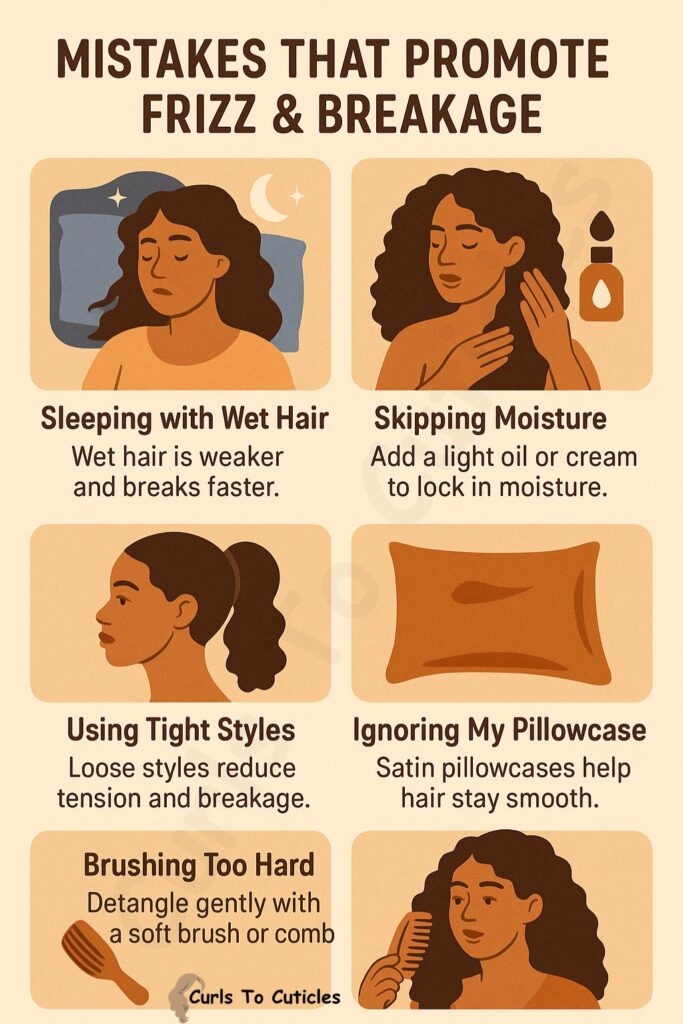Now Reading: My 9-Minute Nighttime Hair Routine That Prevents Frizz & Breakage
-
01
My 9-Minute Nighttime Hair Routine That Prevents Frizz & Breakage
My 9-Minute Nighttime Hair Routine That Prevents Frizz & Breakage

Taking care of your hair at night is one of the easiest ways to keep it healthy. I’ve tried long routines. I’ve tested different products. But now, I follow a simple five-minute process that actually works. It protects my strands, keeps frizz away, and reduces breakage.
This routine fits into any schedule. You don’t need fancy tools. You don’t need expensive treatments. You just need consistency, the right products, and gentle habits.
Let me walk you through what I do every night to wake up with softer, smoother hair.

Step 1: Detangle My Hair (1.5 Minute)
Before I do anything else, I gently remove any knots or tangles. This step is important. If I skip it, I wake up with more frizz and breakage.
What I use:
- A wide-tooth comb or detangling brush
- A light leave-in conditioner or detangling spray
How I do it:
- I spray a small amount of leave-in conditioner on the ends of my hair.
- I start combing from the bottom and work upward.
- I avoid tugging or forcing the brush through knots.
Why it works:
Tangles can pull on the scalp and tear strands. Detangling at night prevents this and makes my hair smoother in the morning.
Step 2: Apply a Nourishing Oil (2 Minute)
After detangling, I apply a lightweight oil to my ends. This step locks in moisture and helps reduce split ends.
My go-to oils:
- Argan oil
- Jojoba oil
- Sweet almond oil
How much I use:
- Just a few drops. I warm it between my palms before applying.
Where I apply it:
- Mostly on the mid-lengths and ends.
- I avoid the scalp to keep it from getting greasy.
Why this matters:
Hair loses moisture overnight. Oil creates a barrier that holds hydration in and keeps dryness out.
Step 3: Scalp Massage (1.5 Minutes)
I don’t skip this. A quick scalp massage before bed helps improve blood flow and supports hair growth.
How I do it:
- I use my fingertips, not my nails.
- I gently move in circles for about 30 seconds.
Optional tools:
- A soft silicone scalp brush (good for thicker hair)
Benefits:
- Promotes circulation
- Relieves tension
- Helps distribute natural oils
It feels good, takes little time, and supports long-term hair health.
Step 4: Protect My Hair While Sleeping (1 Minute)
What you sleep on matters. Cotton pillowcases cause friction. That leads to frizz and breakage. I always protect my hair before I sleep.
My preferred tools:
- Satin or silk bonnet
- Satin pillowcase
- Satin scrunchie
What I do:
- If I wear my hair down, I use a satin pillowcase.
- If I want extra protection, I wear a bonnet.
- Sometimes I do a loose braid or pineapple bun with a satin scrunchie.
Why this works:
Satin and silk reduce friction. They help hair glide instead of snag. This keeps the cuticle smooth and lowers the chance of damage.
Step 5: Tie Hair Gently (If Needed) (1.5 Minutes)
Some nights, I tie my hair up. Other nights, I leave it down. But if I tie it, I’m careful about how I do it.
Good styles for sleep:
- Loose braid
- Pineapple bun (for curls)
- Low ponytail with a soft tie
What I avoid:
- Tight hair ties
- Rubber bands
- Pulling hair back harshly
Why it helps:
Tying hair loosely keeps it from tangling. It also prevents rubbing and pulling during sleep.
Bonus Tips I Use Weekly (But Not Nightly)
The 9-minute routine above is what I do every night. But once or twice a week, I add extra steps to give my hair more support.
1. Deep Conditioning Treatment
- I use a deep conditioner or mask after my usual shampoo.
- I leave it on for 15–30 minutes.
- This adds extra moisture and helps repair damage.
2. Scalp Oil Treatment
- I massage a bit of oil into my scalp before bed.
- I leave it overnight and rinse in the morning.
- I do this only once a week.
3. Clarifying Wash
- Once every 10 days, I use a clarifying shampoo.
- This removes buildup from products and oils.
- It keeps my scalp healthy and clean.
These steps don’t take much time, but they boost the results of my everyday routine.
Common Mistakes I Stopped Making
I used to wonder why my hair broke so easily. Then I noticed I was making small mistakes without realizing it. Here’s what I changed:
1. Sleeping with Wet Hair
Wet hair is weaker. It stretches more and breaks faster. Now I always dry my hair before sleeping, even if it’s just air drying for an hour.
2. Skipping Moisture
Dry hair breaks faster. I used to go to bed with clean but dry hair. Now I always add a light oil or cream to lock in moisture.
3. Using Tight Styles
I used to wear tight buns or ponytails at night. They caused tension and breakage, especially near my edges. Loose styles are safer.
4. Ignoring My Pillowcase
Switching to satin made a big difference. Cotton absorbed my hair’s moisture and caused frizz. Satin helps my hair stay smooth.
5. Brushing Too Hard
Brushing roughly caused breakage. Now I detangle gently, starting at the ends. I use a soft brush or comb and take my time.
Download Below Infographic For Future Use

How I Pick the Right Products
My routine works because I choose the right products for my hair type. I focus on moisture, softness, and protection.
Here’s how I choose:
- I read the ingredient list.
- I avoid heavy alcohols and sulfates.
- I look for words like “hydrating,” “nourishing,” and “lightweight.”
Good ingredients:
- Aloe vera
- Glycerin
- Coconut oil (in small amounts)
- Shea butter
- Panthenol
What I avoid:
- Drying alcohols
- Mineral oil
- Heavy waxes
- Synthetic fragrance (if it’s strong)
My goal is to keep the routine simple and the ingredients effective.
How This Routine Helps?
Everyone’s hair is different. Here’s what mine is like, and why this routine works for me.
My biggest issues:
- Frizz in humid weather
- Split ends from styling tools
- Tangling while sleeping
Results I’ve seen:
- Less frizz in the morning
- Softer, more defined waves
- Fewer split ends
- Less breakage over time
This shows that even a short routine can make a big difference.
What to Expect If You Try This Routine
This routine is not a miracle fix. It doesn’t work overnight. But if you stick to it for a few weeks, you will notice real results.
Week 1:
- Your hair feels softer.
- Frizz starts to decrease.
- Detangling gets easier.
Week 2–3:
- Hair feels stronger.
- Fewer split ends show up.
- Morning styling takes less time.
Week 4 and beyond:
- Your hair breaks less.
- Growth may improve due to reduced damage.
- Overall texture becomes smoother and more manageable.
Stay consistent. It’s a small investment of time that leads to long-term results.
Why This Routine Only Takes 5 Minutes
Many people think hair care must take a long time. That’s not true. If you plan it right, you can protect your hair in just five minutes.
Here’s a quick breakdown:
- Detangle: 1.5 minute
- Apply oil: 2 minute
- Scalp massage: 1.5 minute
- Protective style or bonnet: 1.5 minutes
- Tie or braid (if needed): 1 minute
I keep everything I need in a drawer near my bed. This helps me stick to the habit without skipping steps.
Final Thoughts
Frizz and breakage don’t happen all at once. They build over time. That’s why prevention matters more than repair. My five-minute nighttime routine stops the damage before it starts.
I don’t use ten different products. I don’t spend an hour getting ready for bed. I use five minutes to make sure my hair stays healthy, soft, and easy to manage.
If you’re tired of waking up with tangled, dry, or frizzy hair, try this simple routine. It’s fast. It’s gentle. It works.
Consistency is the key. Even small habits lead to big changes when you stick to them every night.







